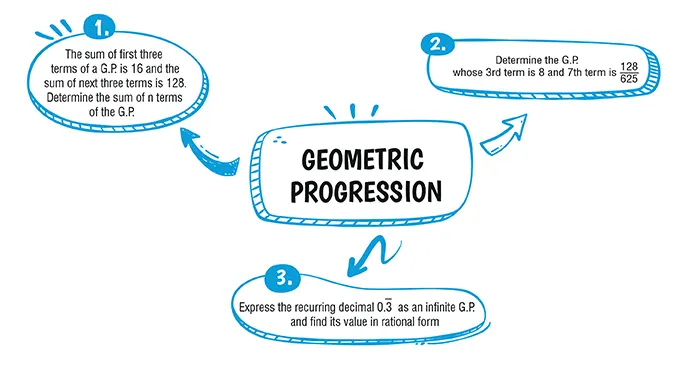Table of Contents

Ans. (c) 20
Explanation:
\text{11th term of the G.P.} \\
\frac{1}{8},\frac{-1}{4} ,2,-1,....is \\
\text{Here, First term} (a)=\frac{1}{8} \\
\text{Common ratio} (r)= \frac{-1}{4} ÷ \frac{1}{8} \\
= \frac{-1}{4} × \frac{8}{1} =-2 \\
=-\frac{1}{4}×8=--2 \\
11^{th} term of G.P.=a^{11} a^{11} = ar^{n-1} \\
= \frac{1}{2^3} × (–1)^{10} × 2^{10} =1×2^{10-3} \\
=2^7 \\
=128.
Ans. (c)
Explanation:
\frac{1}{9},\frac{1} {3},1,-3....Here,\\
\text{Firstterm (a)} = \frac{1}{9}
= \frac{-1}{3} ÷ \frac{1}{9} = \frac{-1}{3} = 9 = - 3 \\
It is a G.P. with r = – 3.
Explanation:
Let a be the first term and r be the common ratio of the G.P. Then, according to given condition,
a + ar + ar^2 = 16 …(i)\\
and \space \space
ar^3 + ar^4 + ar^5 = 128 …(ii) \\
⇒ a (1 + r + r^2) = 16 \space and \space ar^3 (1 + r + r^2) = 128 \\
⇒ \frac{ar^3(1+r+r^2)}{a(1+r+r^2)}\\
= \frac{128}{16} \\
⇒ r^3 = 8 \\
⇒ r = 2 Putting r = 2 in equation (i),
we get
a + 2a + 4a = 16
⇒ 7a = 16
⇒ a = \frac{16}{7}\\
∴ \text{Sum of n terms,}\space Sn = \frac{a(r-1)}{r - 1} \\
⇒ S_n = \frac{16}{7}\\ \left(\frac{2^n – n}{2 – 1} \right)\\
=\frac{16}{7}(2n-1)
Explanation:
Given:
a^3 = 8 \space and \space a^7 = \frac{128}{625} \\
Let a, ar, ar^2, …… be the G.P.
Then, a^3 = ar^2 \space and \space a^7 = ar^6 \\
\text{Now,}\\
\frac{a_7}{a_3} = \frac{ar^6}{ar^2} = r^4 \space \text{and} \space \frac{a_7}{a_3} = \frac{128}{625×8} = \frac{16}{625} \\
∴ r^4 = \frac{16}{625} = \begin{pmatrix} \frac{2}{5}\end{pmatrix}^4 \\
\Rightarrow r = ± \frac{2}{5} \\
\space As \space ar^2 = 8a = 8 × \begin{pmatrix} \frac{5}{2}\end{pmatrix}^2 \\
=\frac{8×25}{4} = 50 \\
∴ G.P. is 50, 20, 8, …… (when r = 2/5).
or 50, – 20, 8, …… (when r = – 2/5).
Explanation:
0.\={3} =0⋅3333333… \\
=0⋅3+0⋅03+0⋅003+0⋅0003+... \\
=\frac{3}{10} + \frac{3}{10^2} + \frac{3}{10^3} + \frac{3}{10^4} + \text{.........The above is an infinite G.P.} \\
\text{with the first term
a} = \frac{3}{10} \space and \space r = \frac{\frac{3}{10^2}}{\frac{3}{10}} = \frac{1}{10}<1 \\
\text{Hence, by using the formula}
S= \frac{a}{1-r},\\
\text{we get}\\
0. \={3} = \frac{\frac{3}{10}}{1-\frac{1}{10}} = \frac{\frac{3}{10}}{\frac{9}{10}} = \frac{3}{9}
= \frac{1}{3} \\
\text{Hence, the recurring decimal}\\
0.\={3} = \frac{1}{3}.
Download Mind Map of this chapter
Download NowWant to Practice Mock Tests of this chapter
Practice NowDownload Important Questions of this chapter
Download Now| Chapter No. | Chapter Name |
|---|---|
| Chapter 1 | Goods and Service Tax (GST) |
| Chapter 2 | Banking |
| Chapter 3 | Shares and Dividends |
| Chapter 4 | Linear inequations |
| Chapter 5 | Quadratic Equations in one variable |
| Chapter 6 | Ratio and proportion |
| Chapter 7 | Factorization |
| Chapter 8 | Matrices |
| Chapter 9 | Arithmetic Progression |
| Chapter 10 | Geometric Progression |
| Chapter 11 | Coordinate Geometry |
| Chapter 12 | Reflection |
| Chapter 13 | Similarity |
| Chapter 14 | Loci |
| Chapter 15 | Circles |
| Chapter 16 | Constructions |
| Chapter 17 | Mensuration |
| Chapter 18 | Trigonometry |
| Chapter 19 | Statistics |
| Chapter 20 | Probability |
| Chapter Wise Important Questions for ICSE Board Class 10 Mathematics |
|---|
| Goods and Service Tax (GST) |
| Banking |
| Shares and Dividends |
| Linear inequations |
| Quadratic Equations in one variable |
| Ratio and proportion |
| Factorization |
| Matrices |
| Arithmetic Progression |
| Geometric Progression |
| Coordinate Geometry |
| Reflection |
| Similarity |
| Loci |
| Circles |
| Constructions |
| Mensuration |
| Trigonometry |
| Statistics |
| Probability |
CBSE Important Questions Class 10
ICSE Important Questions Class 10
CBSE Important Questions Class 10
ICSE Important Questions Class 10